Listen to this article
Could it be that mutual fund distributors (MFDs) are unknowingly causing below average returns for the investors? We know for sure that the MFDs have the best interest at heart for their investors and seek to get the best returns for their investors. Even then why a lot of the investors are victims of poor returns and end up having poor returns in the markets? You will find the answer to what leads to poor returns for investors and also how you as a MFD can help your client to become a better investor and have a great experience in the markets.
How does an average investor’s returns fare?
Historically, in India, people have not looked at the equity markets in a good light and have even compared it to gambling. But, thanks to the MFDs, who acted as the torch bearers of the markets and have spread awareness about the benefits of equities through mutual funds. A large number of people have become aware and have started to see the markets in a different light.
But, have you ever wondered why it has been a herculean task to change the investor perception? It is because, majority of investors have received extremely poor returns, if not negative returns.
A JP Morgan study spread over 20 years (shown in the below chart) finds that average investor returns are the lowest when compared to all other asset classes that they invest in.
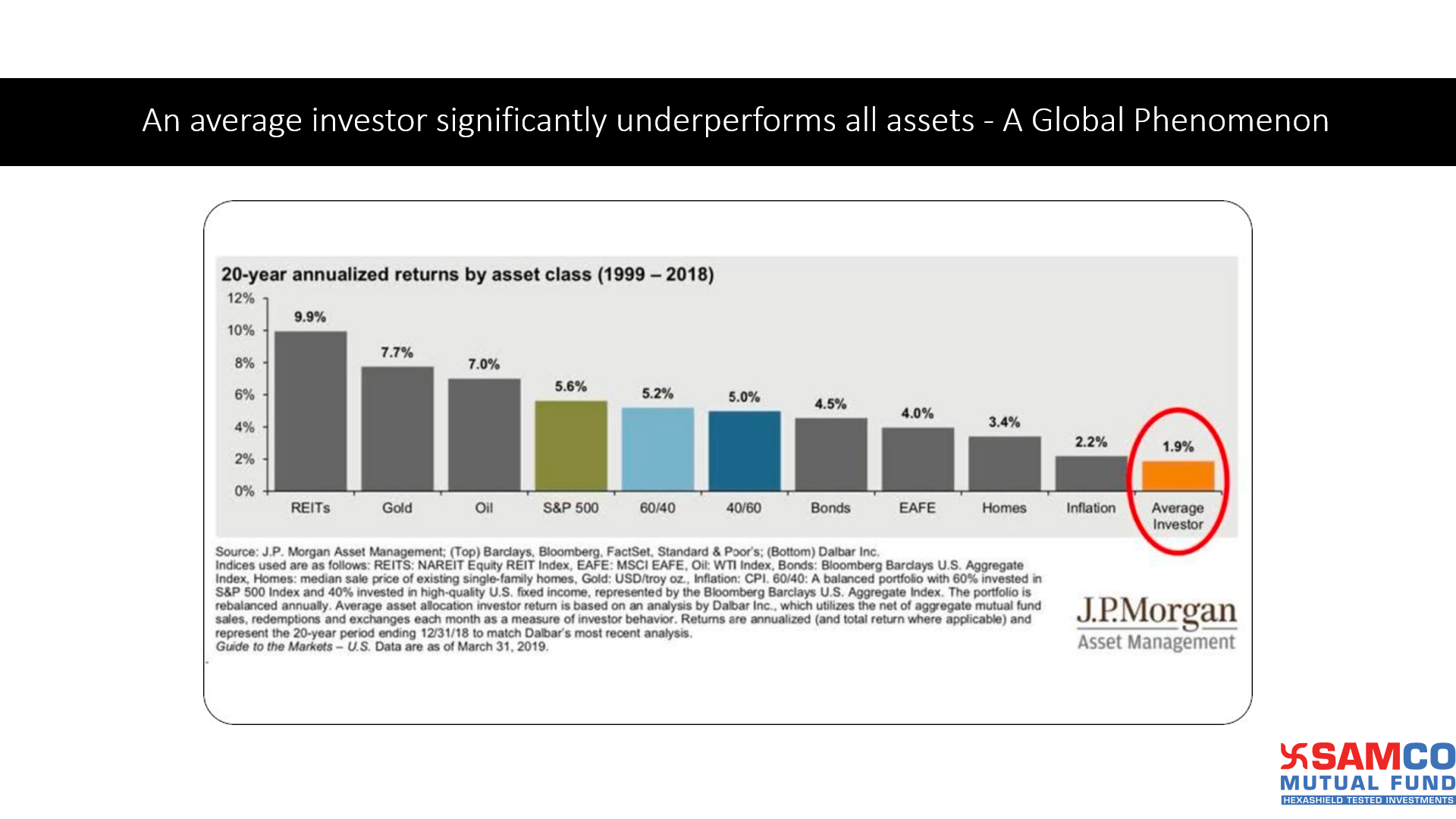
How is that even possible? – Horribly wrong timing!
Investors in general go through a vicious lifecycle as shown below. A lot of us have also been through such cycles at the start of our investing journey and have realised how dangerous it is being sucked in these euphoric times can be. Whenever the markets have been rising a lot, we see few people around us making a lot of money (even doubling or tripling their money) and then with that fear of missing out (FOMO) good returns, we jump in the markets. This FOMO grips the majority of people, and by the time they invest aggressively, the markets may have already shot up significantly and could be trading at extremely high valuations.
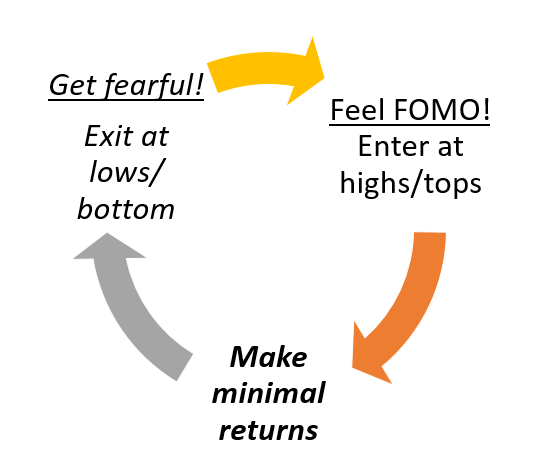
This is also clearly evident from the market participation chart listed below. The volumes in Nifty50 shot up by ~3X in late 2007, when the markets had already gone up by more than 2X in previous three years.
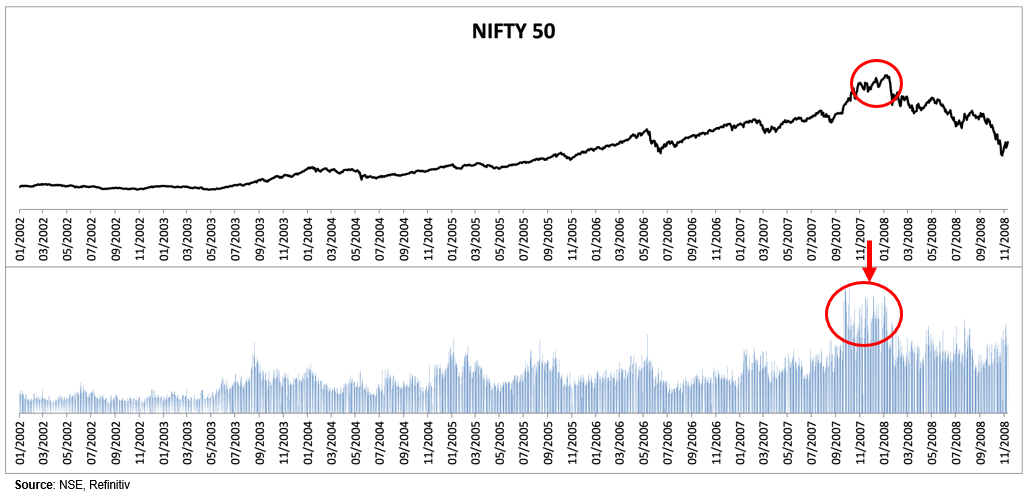
Similar observations were also made in the mutual fund flow. As a distributor, it is easy to convince clients when the markets are trending upwards and a lot of times the investments come to us even without any persuasion. Likewise, with rising markets, the inflow was on the rise as well. However, people panicked and fled the markets when the markets collapsed by more than 60%, post global financial crisis triggered by the collapse of Lehman Brothers in 2008. This actually offered an excellent investment opportunity for the longer term. But in reality, over 5 lakh SIPs were closed in 2009, when market valuations were ridiculously cheap.
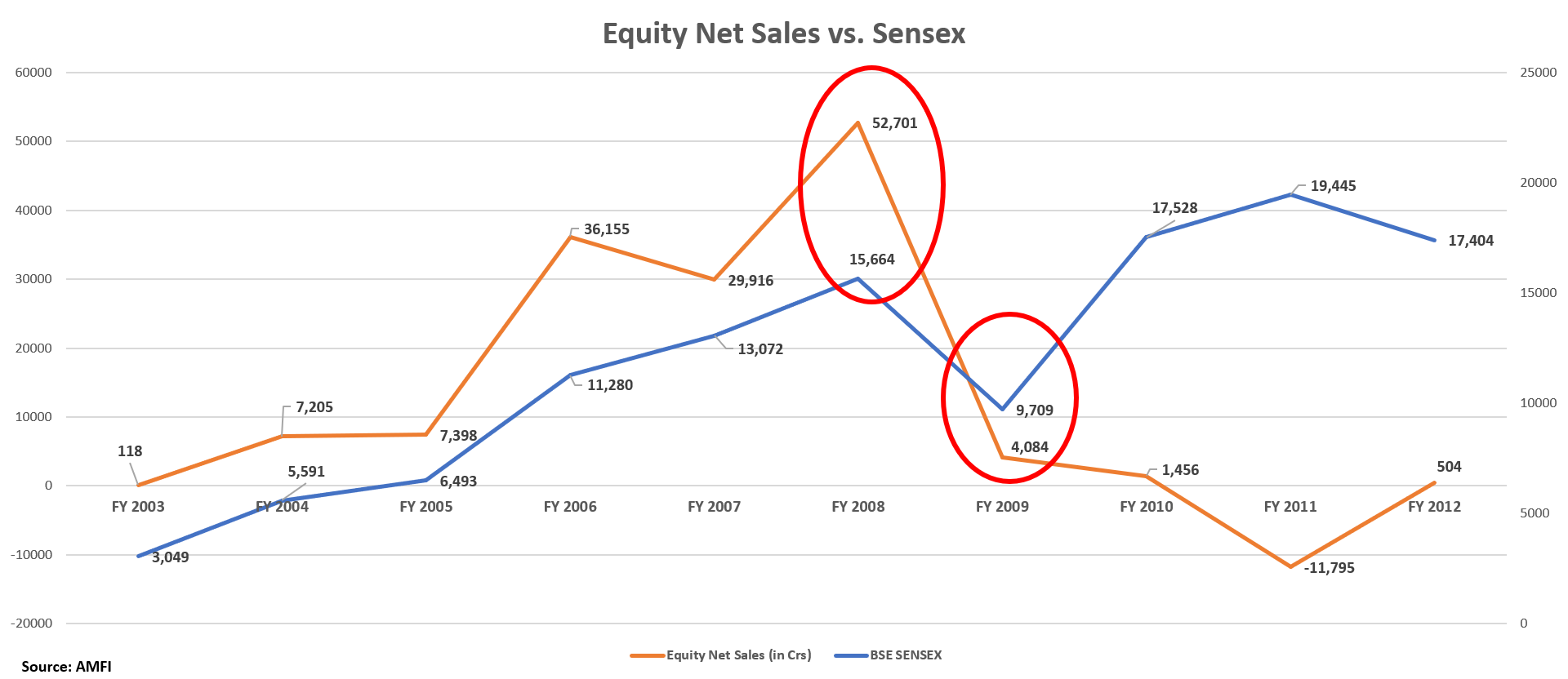
Investing during euphoria leads to poor investor experience
As we have seen above, this cycle keeps on happening from time to time. It also happened in 2020 to 2022. When the markets made a top in late 2021, the number of active NSE monthly investors kept rising until the Russia-Ukraine war broke out. The war announcement, again, was a good opportunity to deploy money, as markets fell more than 10% but the number of active investors fell. This vicious cycle results in unsatisfactory returns for investors, which leads to a negative experience not only for the markets but also for the MFDs and AMCs. This not so good experience makes the investors stay away from the markets for a longer period and they return to the market only when enticed by the next market uptrend.
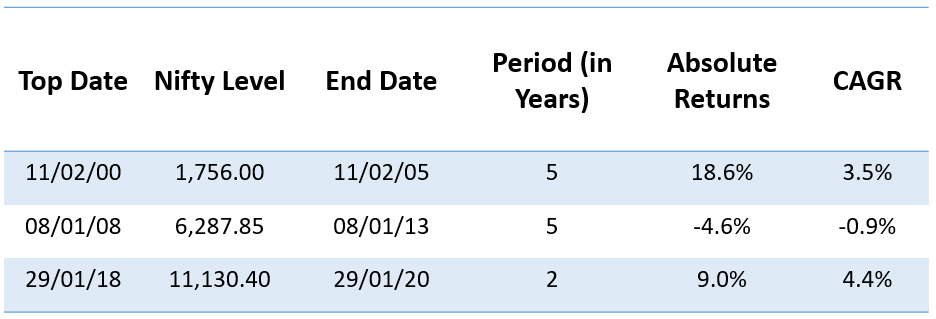
Source: NSE, Refinitiv. Past performance may or may not sustained in the future.
Historically, whenever the investors have invested near or at tops, they have not been able to garner returns even equivalent to FD returns and have experienced significant drawdowns.
Time in the markets v/s timing the markets?
It is popularly said in our industry that “Timing the market is not but time (how longer you stay) in the market is important”. But numbers paint a very different picture just as we saw above. All we are trying to say is that merely time in the markets is not enough. As we have established above that investing at or near the top can lead to extremely sub-par returns for a very long period of time, sometimes even decades.
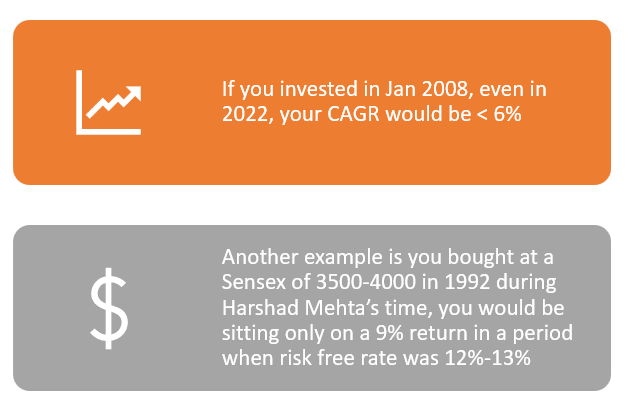
If you get your timing “horribly wrong” it could hurt you for the next 10/20 years.
What’s stopping investors from earning big returns?
This vicious cycle and results have been well known to the industry, as well as many investors, but still, neither have been able to change their respective behaviour. These mistakes keep on repeating, time and again. The one thing that stops the majority of investors out there from being rational are their own emotions. How can we control emotions impacting our investment decisions?
Yes, this is possible, through margin of safety. We have known the concept of Margin of Safety for more than 4 decades now and still are not able to follow.
Imagine you are in your office, it is 2008 and the markets have fallen more than 40-50%, there is no level at which the markets are taking a break from the free fall. Would you be able to call your broker and ask to buy stocks? Or call and ask your clients to invest in equity mutual funds? For most of us, the answer is ‘No’. Even when the markets are running up, especially penny stocks, it is very difficult to exit them.
To make investors better than the average by taking out emotions from the investment process, Samco Mutual fund has integrated the concept of Margin of Safety with technology with no human intervention, it is called - Equity Margin of Safety Index (EMOSI).
EMOSI is based on the margin of safety investing principle, which is represented by a range of values between 1-200 where, 1 denotes the lowest margin of safety and 200 denotes the highest.
It is derived by assigning different weights to various macro and technical factors such as Price to Earnings (PE), G-Sec yields, moving average divergences (MAD), market breadth, etc. Samco has integrated EMOSI in its Timer STP product and aims to help investors avoid mis-timing the market leading to better returns and lower drawdowns.
EMOSI avoids mis-timing the markets
EMOSI is inversely proportional to the broad-based market indices, meaning, whenever the markets are attractive, EMOSI goes up and when markets are expensive EMOSI comes down, indicating when to invest and when to avoid investing in the equity markets.
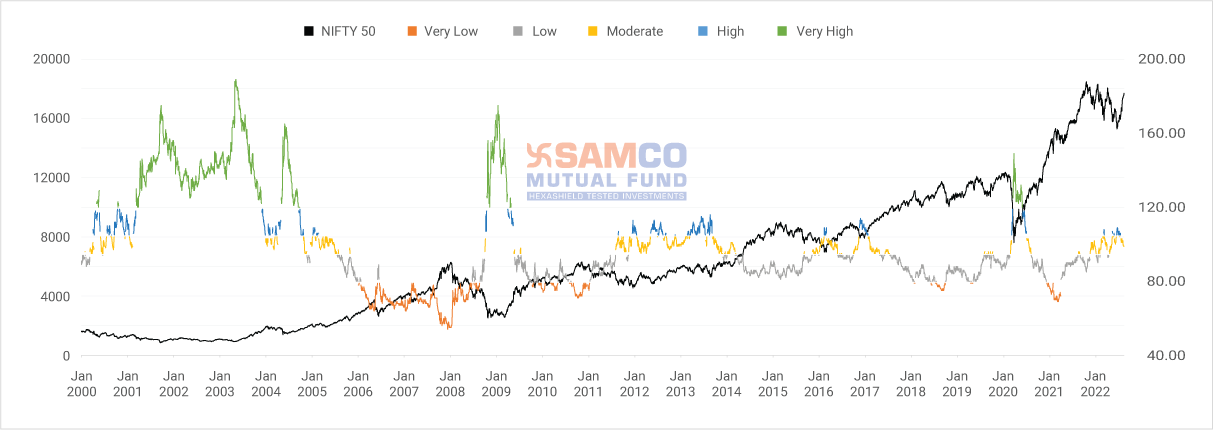
The chart shown above is only for illustrative purposes. The information contained herein should not be construed as forecast or promise of any return.
EMOSI acts as a great Lumpsum Indicator.
EMOSI acts as a perfect indicator for lump-sum investing. Both 3 years and 5 years average returns of Nifty50 are positively correlated with EMOSI. As EMOSI goes up, the average 3/5 year return goes up and vice versa.
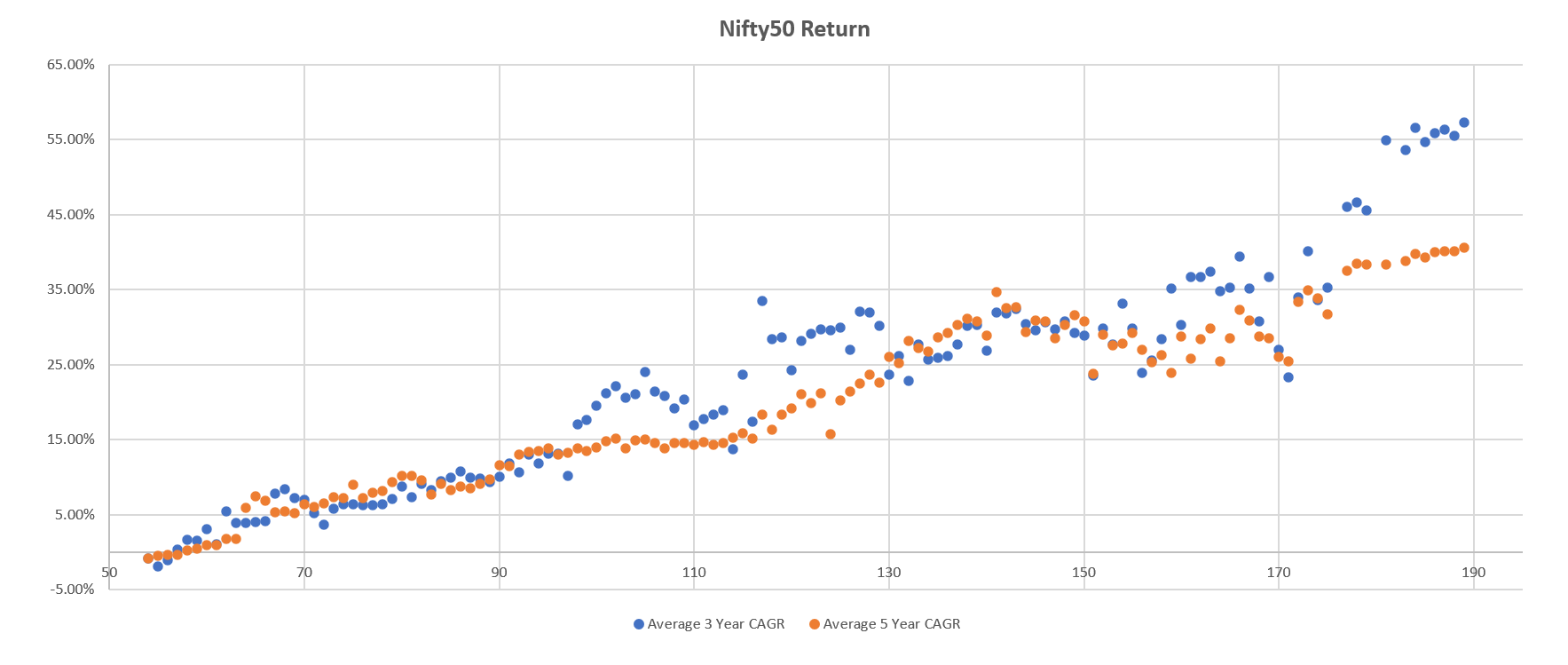
The chart shown above is only for illustrative purposes. The information contained herein should not be construed as forecast or promise of any return.
When markets are low, TimerSTP invests aggressively
When the markets are high EMOSI allows TimerSTP to “invest cautiously” i.e. deduct lower multiples (up to 0.01X)* of the base instalment from the source scheme, thus minimising the equity exposure. Similarly, when markets are low, TimerSTP “invests aggressively” i.e deducts higher multiples (up to 6X) of the base instalment from the source scheme and transfers it to the target scheme, ensuring maximum equity exposure.
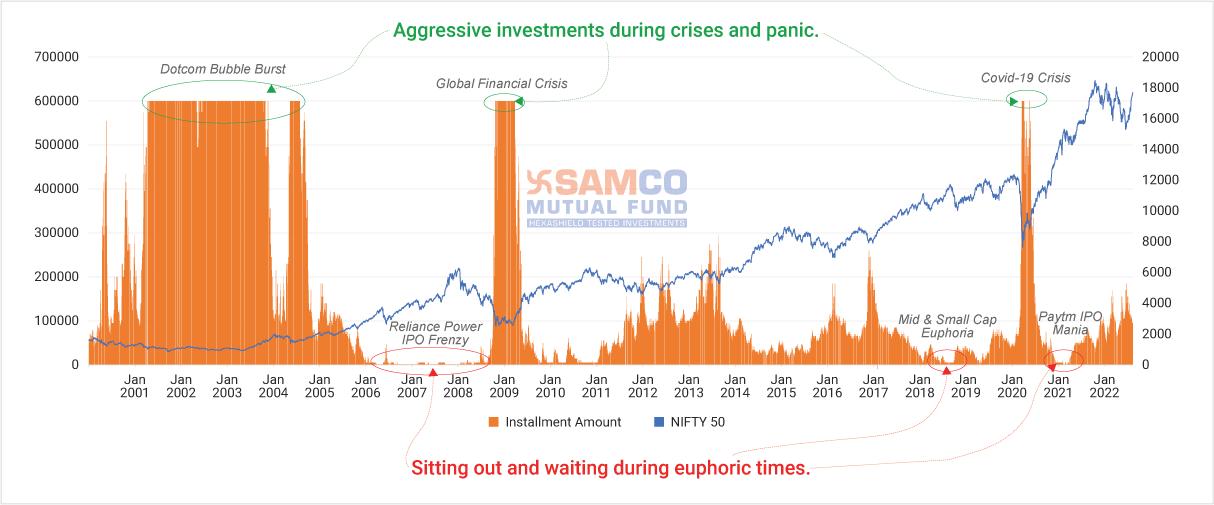
The chart shown above is only for illustrative purposes. The information contained herein should not be construed as forecast or promise of any return.
Illustration of TimerSTP
Below is an illustration of how a Timer STP setup in Jan 2020 for Rs.12,00,000, in source scheme, would move to target scheme based on EMOSI. Returns from TimerSTP are significantly higher at ~22.44 Lakhs vs. only ~19.54 Lakhs in a normal 12 month STP.
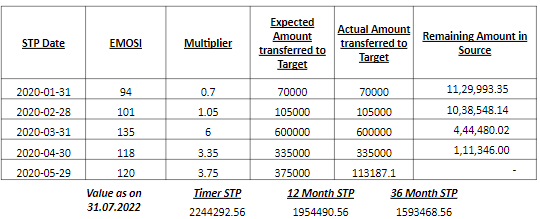
Source – Internal Research. Based on Back-tested data of rolling returns for STP setup in each month. For 36 month STP, 12 month STP and TimerSTP, Ending value are based on total return of source scheme i.e. Crisil Short Term Fund Index and Target Scheme - NIFTY 50. The above returns are of benchmark/index and do not indicate returns of any scheme. The lumpsum investment amount is Rs. 12,00,000 in Source Fund (Crisil Short Term Bond Index Fund) transferred through monthly Timer STP to Nifty50 Index. Timer STP is applied to Base Instalment amount is Rs. 1,00,000.
Potential Alpha Generation from TimerSTP vs Normal STP
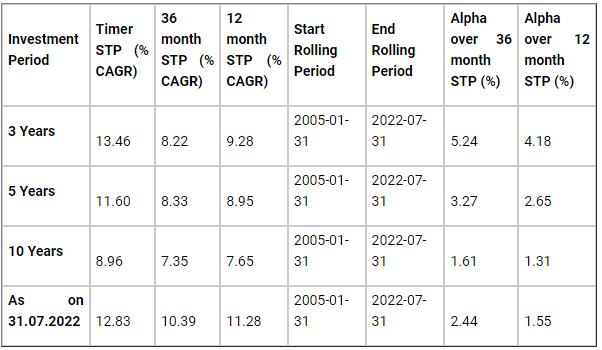
* Source – NSE, Refinitiv. Based on Back-tested data of rolling returns for STP setup in each month from January 2005 till July 2022. For 36 month STP, 12 month STP and TimerSTP, CAGR returns are based on total return of source scheme i.e. Crisil Short Term Fund Index and Target Scheme - NIFTY 50. The above returns are of benchmark/index and do not indicate returns of any scheme. CAGR = [(Ending Value/Beginning Value) ^ (1/No. of Years)]-1. The lumpsum investment amount is Rs. 12,00,000 in Source Fund transferred through monthly Timer STP to Nifty50 Index. Timer STP is applied to Base Instalment amount is Rs. 1,00,000. CAGR is calculated on both source and target schemes.
# The TimerSTP multiplier is the multiplier applied to the base instalment amount. In case of regular 36 month and 12 month STP, the multiplier is default 1 as base amount. In case of TimerSTP, it shall be a number between 0.01 - 6. For Eg. If the base instalment amount is Rs. 100000, and the corresponding multiplier value is 0.01 on date of STP, then the amount that shall be transferred from Source Scheme to Target Scheme is Rs. 1000. If the multiplier is 6, then the amount that shall be transferred from Source Scheme to Target Scheme is Rs. 600000. The multiplier is linked to SAMCO’s proprietary Equity Margin of Safety Index which is derived from multiple factors such as Price to Earnings (PE), G-sec yields, moving average divergences and / or other fundamental and technical factors as may be determined by the AMC from time to time.
TimerSTP is the medium which helps take emotions (the biggest enemy of great returns) out of the investment decisions. It helps investors and distributors to avoid a ‘Horribly wrong time’ to invest in the markets. A lot of MFDs have concurred that the most difficult time to handle client emotions is when their portfolios are down by 10-20-30%. With TimerSTP, these drawdowns can be reduced significantly and it helps in giving a better experience for your clients through better returns and lower volatility.
To use EMOSI value as a lump-sum indicator too, you can easily find it at https://www.samcomf.com/timer-stp-emosi. As this is a completely automated process, the daily EMOSI value is published on our website for your ready reference.
In order to begin the TimerSTP journey for the investor, he/she has to begin with a minimum of Rs 25,000 in the source fund, which is Samco Overnight Fund and thereafter, Timer STP can be registered.
NFO dates for Samco Overnight Fund October 4th to 6th, 2022
Start your TimerSTP TODAY - https://www.samcomf.com/investor/login !





